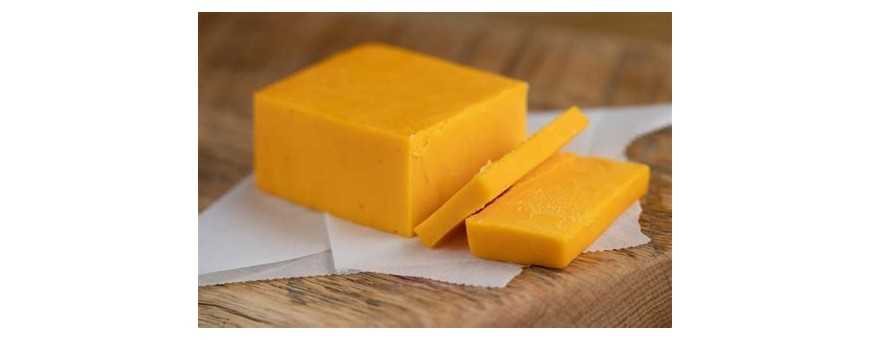Sorry for the inconvenience.
Search again what you are looking for
SOXLANA offers you everything you need. Be satisfied first and then pay later.

Cheddar is a pale yellow cheese with a strong flavor made from cow's milk. He is originally from the English village of Cheddar in Somerset. It comes in different varieties in several countries: United Kingdom, Ireland, Canada, United States, South Africa, New Zealand, Australia and Sweden. It is most often produced in mass, and its quality varies greatly from variety to variety. The strong taste develops over time, enough to prompt growers to mention its “strength”: sweet, medium, strong and extra strong, or its ripening period.
Food intake
Cheddar cheese is a good source of vitamin B12. A 40 g slice contains about 0.5 µg.
100 g of cheddar cheese represents approximately 380 kcal.
Description
This cheese is sold mainly in the form of a brick, a cylinder or particularly in North America in the form of grains. In the dairy pools where it appears, it tends to form twisted cigar-shaped clumps, which are commonly referred to as "grains". To create the bricks, the grains are heated, pressed and cut into blocks. These blocks are then stacked, allowing the whey to flow.
The West Country Farmhouse Cheddar Protected Designation of Origin requires the use of ingredients harvested in the four English counties shown on this map.
This type of cheese is so widespread that it is now impossible to give it a designation of origin. However, the European Union recognizes the protected designation of origin West Country Farmhouse Cheddar. To keep it, the cheese must be made the traditional way with local ingredients from four counties of Dorset, Somerset, Devon and Cornwall in the South West of England and matured for at least 9 months. In 2019 a PDO cheddar made in Weston-super-Mare in Somerset was ranked fourth best cheese in the world out of a selection of 3,804 cheeses from 42 different countries.
The color of the cheese is sometimes changed with the help of food coloring. Annatto, extracted from a tropical tree, is often added to give the color orange. This practice is used by industrial manufacturers such as Kraft but is strictly prohibited in the specifications of the PDO West Country farmhouse Cheddar. It is not known exactly when this practice dates back, as are the reasons for doing so. There are three theories:
ensure consistency of color of cheese from batch to batch;
help the buyer choose the type of cheese if it is not identified;
identify the region of production.
Probably the best-selling cheese on the planet [ref. necessary], it was initially [unclear] wrapped in black wax, although this practice is now limited to Europe and maintained by artisan cheese makers.
In the United States, there are different varieties: Classic, New York, Colby / Longhorn, White and Vermont. New York has a strong taste, sometimes with a smoky scent. The taste of Colby / Longhorn is somewhere between mild and medium. The grains are visible because they are colored yellow cream. Cheddar cheese without coloring is often referred to as white cheddar or Vermont cheddar, whether or not it was produced in the state of Vermont.
This cheese is a food regularly monitored by the USDA (United States Department of Agriculture) to observe the dairy industry. This organization produces weekly reports on prices and quantities produced. In the United States, Wisconsin produces the most of this cheese. The other important locations are in New York State, Vermont, and Tillamook, Oregon.
Its production is also important in Canada, where it was established in the 19th century to supply the British market, before quickly establishing itself on the local market. There are varieties of mild, medium or strong cheddar, depending on the aging. The sweet is offered in “yellow” cheddar or “white” cheddar. Aged cheddars are generally white.
Historical
The cheese originates from the village of Cheddar in Somerset, South West England. The Cheddar Gorges on the edge of the village have a number of caves which provided ideal humidity and constant temperature for the cheese to ripen.
Traditionally, cheddar cheese should be made within 30 mi (48 km) of Wells Cathedral. Cheddar has been produced since at least the 12th century. An accounting document from King Henry II (King of England) dating from 1170, records the purchase of 10,240 pounds (4,640 kg) at one farthing per pound.
The biggest known cheeses
White House historians say United States President Andrew Jackson held a party where a 1,400 pound (635 kg) block of cheddar cheese was served as an appetizer. A 7,000 pound (3,175 kg) block was produced at Ingersoll, Ontario in 1866 and exhibited in New York and Great Britain. He is immortalized by the poem by Canadian James McIntyre, Ode on the Mammoth Cheese Weighing over 7,000 Pounds. A larger block was produced in Wisconsin, 34,951 pounds (15,853 kg), for the New York World's Fair in 1964. To produce it, it is estimated that the daily milk production of 16,000 cows was required.
Search again what you are looking for
This website uses cookies. By continuing to browse the site, you accept our use of cookies. En savoir plus ici.
